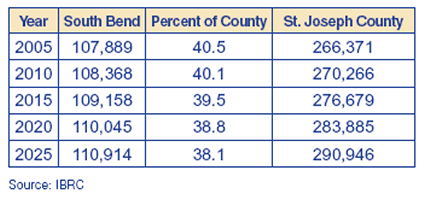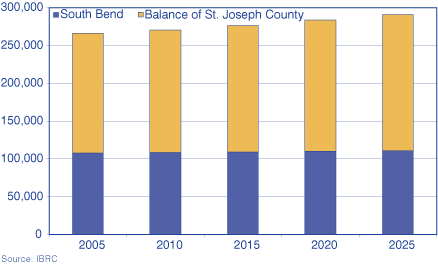Planning a City's Future: The South Bend Population Projections
The Indiana Business Research Center is responsible for generating the official population projections for Indiana and its 92 counties. While the Center does not regularly create projections for Indiana’s cities, sometimes the need does arise. Planners for South Bend have recently been working on a 20-year comprehensive plan, and they sought our expertise in developing population projections for their city. (1)
Table 1 shows the projections generated for South Bend, as well as the projections previously produced for St. Joseph County (released July 2003). (2)
Table 1: Population Projections

Figure 1 illustrates that South Bend’s expected growth is very small throughout the projected horizon, while the population of St. Joseph County as a whole is expected to increase by about 25,000 residents. South Bend’s share of St. Joseph County’s population is expected to decrease from 40.5 percent in 2005 to 38.1 percent in 2025.
Figure 1: Projected Population Shares 2005 to 2025

Details about the projected South Bend population with regard to age, sex, race and Hispanic ethnicity were also necessary for the city’s planning efforts. The requested race categories were white alone, black alone, all other races alone and two or more races. (Note that Hispanic is considered an ethnicity, not a race.)
Implications for Housing
Demand for housing will not increase much based on current trends and projected population growth. As seen in Figure 1, the size of South Bend’s population is expected to change very little over the planning horizon. Therefore, it will remain challenging to fill the existing excess housing capacity.
According to the 2000 Census, 7.4 percent of the housing units in South Bend were vacant, compared to 7.6 percent in 1990. Of the units occupied in 2000, 36.9 percent were renter-occupied compared to 34.1 percent in 1990. Therefore, the vacancy rate should continue to decrease very slightly, while the proportion of renter-occupied units is likely to increase.
Developers may be drawn to the suburban areas of the county where more population growth is expected. However, the city does not face the utilities and infrastructure challenges encountered with ever-increasing suburbanization. Moreover, tax abatements provided to residences in certain parts of South Bend may entice some people to stay within the city limits. City planners may also wish to brainstorm about creative ways to encourage developers to take on urban renewal projects, along with the possibility of using annexation to capture more of the surrounding growth.
Implications for Education
The population of school-age children, like the overall population, is projected to change very little over the planning horizon (see Table 2).
Table 2: Projected Population, Age 5 to 19 Years Old
A slight decrease in total numbers is expected through the remainder of the current decade, followed by slight increases thereafter. This is due to a combination of demographic effects, such as changes in the number of women of child-bearing age, differing fertility rates by age group, etc. (Note that the figure projected for the year 2025 is slightly lower than the 2005 figure.)
More noteworthy are the expected shifts in the race and Hispanic proportions. In particular, it appears that an increased effort to accommodate the educational needs of the growing Hispanic and multiracial populations will be required. The Hispanic population, as a share of the total for this age group, is expected to increase by 5.1 percentage points over the 20-year planning horizon. Meanwhile, the proportion within the “two or more races” category is expected to increase by 3.2 percentage points, and the “all other races alone” group is predicted to rise by 2.4 percentage points. These projections serve as a testament to the increasing diversity of the South Bend community in general and the imminent increase in multiculturalism within the city’s schools.
Implications for Economic Development
One of the things those involved with economic development efforts may need to consider is the size of the available workforce. The population age 25 to 54 (the prime working years) is expected to decrease by 3,762 over the 20-year period. That is not a huge decrease, but it is certainly worth noting.
As is the case for education, the race and ethnicity shifts are also relevant considerations for economic developers (see Table 3). The shifts for this age group are not as big as those projected for the school-age population, but they are nonetheless worthy of note. The proportion of working-age Hispanics is expected to rise by 3.1 percentage points, while that of the “two or more races” group will increase by 1.8 percentage points, and the “all other races alone” category is predicted to gain 2.1 percentage points.
Table 3: Projected Population, Age 25 to 54 Years Old
As time goes on, it will be even more advantageous for business leaders and managers to have bilingual or multilingual capabilities to communicate effectively with workers who have varying degrees of proficiency with the English language. This is especially the case for entrepreneurs and managers who wish to develop new opportunities in the services industries, since many of those businesses may seek low-skilled or semi-skilled labor that is often supplied by international migrants. This also applies to businesses who wish to leverage the high-skilled talents of the international students and graduates of the University of Notre Dame.
Having said all of that, economic developers are not stuck with the hand that has been dealt by our population projections. If economic developers are able to stimulate growth in employment opportunities in South Bend, new working-age residents should be attracted to the area.
Notes
- This article is a summary of a report prepared for the City of South Bend.
- Projections through 2040 for Indiana and all 92 counties are available at www.stats.indiana.edu/pop_proj/.
By Vincent Thompson, Economic Analyst
Indiana Business Research Center, Kelley School of Business, Indiana
University


